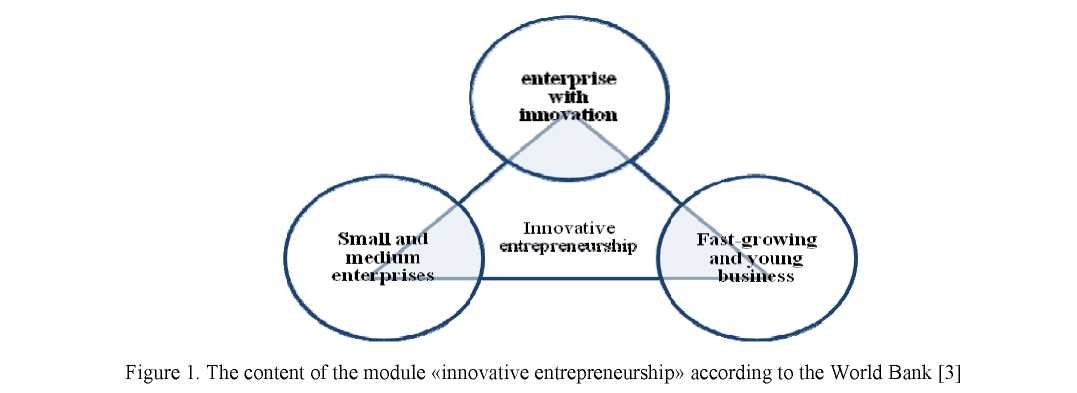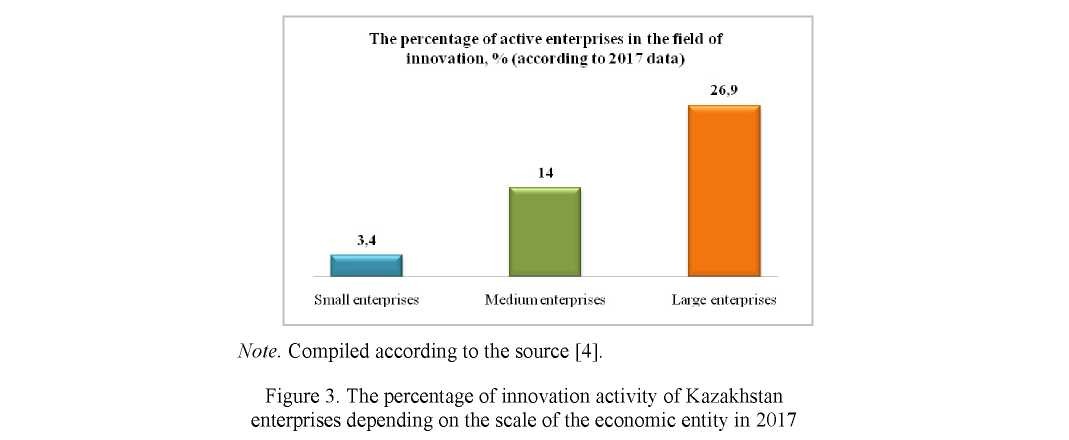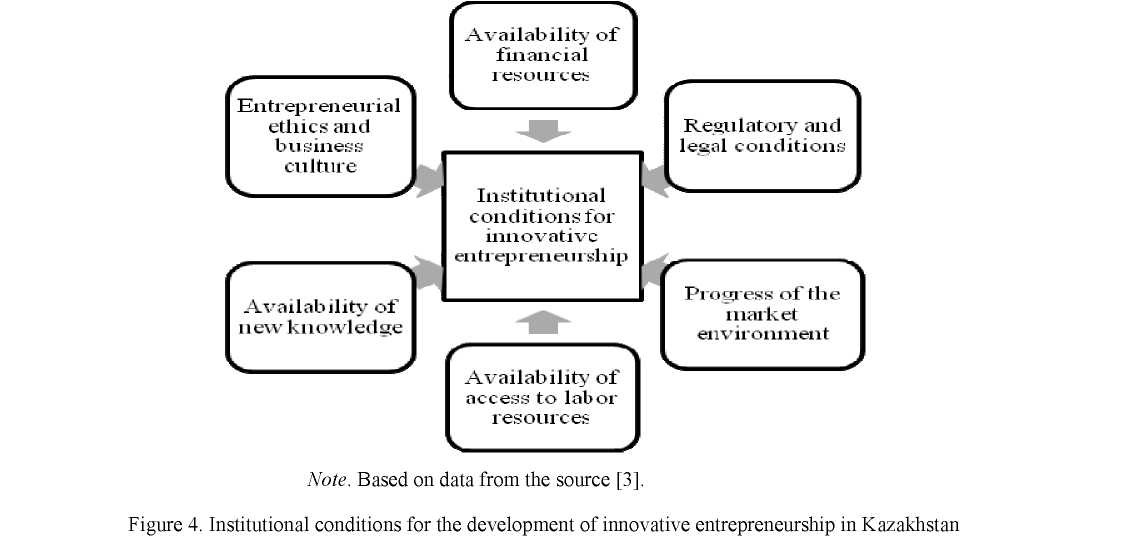In the article the participation of the state in the creation of institutional prerequisites that contribute to the development and revitalization of innovative business entities is considered. The definition of innovative entrepreneurship as a specific actor of innovative relations is given. Its internal characteristics are highlighted. We study the relationship of small, medium and large businesses to innovative processes. This is done on the basis of the proportion of innovatively active enterprises in Kazakhstan at the country level and in the regional context. The general and specific problems that hinder the innovation processes faced by enterprises of various sizes are described. It is noted that Kazakhstani businessmen to a greater extent demonstrate the imitative nature of production behavior, regardless of the scale of the enterprise, which carries out various types of innovation. It is also revealed that large companies are the most innovative in Kazakhstan, because they are largely provided with the necessary conditions for this. Several priority areas of state participation in terms of accelerating the development of innovation activities are highlighted. Proposals for improving public administration in the formation of institutional conditions for innovative entrepreneurship are made.
The state as a subject of public relations and public administration are important components of the innovation system. From direct financing of education and R&D to the creation of various regulatory and legal conditions, they can have a significant impact on innovation activities. Obviously, full-fledged public administration, implemented through innovation policy, will be implemented in a wide range of «traditional policy areas», and will go far beyond a narrow understanding of innovation, including education, industry, taxation, ecology, finance, etc.
Targets of the modern innovative development of the Republic of Kazakhstan are determined taking into account the implementation of the main directions reflected in the annual Presidential Address to the people of Kazakhstan, the strategic document «Kazakhstan-2050», the State Program of Forced Industrial-Innovative Development for 2015-2019, the Strategic Development Plan of Kazakhstan until 2020 of the year, «The Concept of entering Kazakhstan among the 30 most developed countries in the world», etc.
Leading Kazakhstan scientists and their co-authors emphasize that many program-targeted initiatives have low performance due to the presence of serious problems, despite the active reform of Kazakhstan society [1]:
- The existence of administrative obstacles, in particular in the licensing system when creating a business for entrepreneurs;
- Inefficient system of organization of export-import operations in the presence of relative openness of market relations;
- Inefficient organization of the customs system;
- Lack of clear definition of performance targets in a significant part of state development programs;
- Inefficiency in the use of budget funds allocated for the implementation of state programs.
The state remains a decisive participant in innovation processes at this stage of development of all system elements of the national innovation system of Kazakhstan. However, the efforts of only states will not have a positive result if other participants of the innovation system will take passive positions. Therefore, it is necessary to emphasize the importance of other actors directly involved in innovative relations. It is also necessary to consider the conditions created for the development of innovative processes in Kazakhstan.
Innovative entrepreneurship is one of those. This is the part of the innovation system that most influences the effectiveness of measures taken to create and implement a country's scientific, technological and innovation policy. Representatives of innovative entrepreneurship are the main indicator of the susceptibility of society to innovation.
Various factors contribute to the formation of innovative entrepreneurship. These include: the type of socio-economic system of the state, the structure or level of scientific and technological development, the potential for human development, the openness of the country's economy, etc. Note also that countries with an identical type of socio-economic relations often have differences in the scientific and technological sphere and focus on different levels of research cycles in research and development (fundamental and / or applied). In this connection, the national specificity of innovative entrepreneurship is manifested in the contours of the overall national innovation model.
Although the models differ from each other by [2]:
- the role and extent of state presence in innovation;
- the participation of the private sector in innovatively active industries;
- the relative importance and place of large, medium and small businesses;
- the correlation between fundamental and applied research and development, etc.
While state authorities unite their efforts in solving various social problems, innovative entrepreneurship can play a key role in creating and expanding the labor market and new jobs. It can solve social and economic problems in general in Kazakhstan and its regions in particular.
According to the World Bank's approach to the essence of innovative entrepreneurship, it cannot be described only as: an enterprise introducing innovations, small and medium-sized businesses or young and fastgrowing participants in modern economic relations. Innovative entrepreneurship is formed at the intersection of these three characteristics (Fig. 1):
Quite often, the concept of «innovative entrepreneurship» is associated with small and medium-sized businesses. Although in our opinion, this is not entirely consistent with reality. In fact, economic entities of various sizes are interested in innovative entrepreneurship. This is evidenced by the data provided annually by the Committee on Statistics of the Republic of Kazakhstan. So, for example, in 2017, the innovation activity of Kazakhstani enterprises of different scales looked like that shown in Figure 2.
The figure shows that representatives of small businesses carried out various kinds of innovations in the volume (897 units), almost twice the figures of medium (375 units) and large (498 units) enterprises in 2017. Also, data show that large enterprises in terms of innovation were more active than medium ones. Thereby, the existing stereotype does not confirm that big business is the most disinterested in introducing innovations.

In addition, when analyzing the coefficient of innovation activity, determined by the ratio of subjects with innovations, and their total number (Fig. 3), it is Kazakhstan's large business that is the most innovatively active.
Figure 3 demonstrates that large enterprises are almost twice as fast in innovation activity of mediumsized businesses and almost eight times more active than small businesses. Indeed, large corporations have more opportunities and tools to innovate, providing the opposition, thus the competition.
Nevertheless, regardless of the scale of activity, the subjects of innovative entrepreneurship of the country make greater use of the imitative nature of production behavior. Enterprises in the country do not create radical innovative business conditions on their own. The practice of borrowing ready-made innovations and new technologies by the Kazakhstani business indicates this. According to Andreeva G.M., Kazakhstani enterprises are more prone to adapting ready-made technological solutions and absorbing innovations than to offering and using their own innovations [5; 33]. Therefore, the state occupies a leading position in the modern innovation system of Kazakhstan, and offers to all interested in the innovation processes structures, all its existing backup capabilities.
The overall success of innovation activity undoubtedly depends on the degree of interaction of state authorities, science, education, and innovative entrepreneurship in the regions. Taking into account the existing trends and fulfilling one of its main functions (managing regional innovation processes) the state should promote and ensure the formation of extensive innovative connections.
An analysis of the innovation activity of enterprises in Kazakhstan's regions, in general, demonstrates a situation similar to the general state of innovation in the country (Table).


Table Innovative activity of Kazakhstan enterprises in 2017 (in terms of regions and scale of business)
|
Region |
Small enterprises |
Medium enterprises |
Large companies |
||||||
|
Number of units |
Innovative enterprises |
Percentage of innovation activity, % |
Number of units |
Innovative enterprises |
Percentage of innovation activity, % |
Number of units |
Innovative enterprises |
Percentage of innovation activity, % |
|
|
Akmola |
1 054 |
36 |
3,4 |
155 |
13 |
8,4 |
90 |
23 |
25,6 |
|
Aktobe |
911 |
26 |
2,9 |
130 |
25 |
19,2 |
108 |
36 |
33,3 |
|
Almaty |
1 550 |
47 |
3,0 |
156 |
16 |
10,3 |
91 |
27 |
29,7 |
|
Atyrau |
952 |
22 |
2,3 |
97 |
12 |
12,4 |
96 |
22 |
22,9 |
|
West Kazakhstan |
757 |
2 |
0,3 |
93 |
7 |
7,5 |
82 |
5 |
6,1 |
|
Zhambyl |
702 |
29 |
4,1 |
73 |
14 |
19,2 |
71 |
16 |
22,5 |
|
Karaganda |
1 896 |
74 |
3,9 |
236 |
35 |
14,8 |
177 |
39 |
22,0 |
|
Kostanay |
1 181 |
52 |
4,4 |
189 |
25 |
13,2 |
105 |
30 |
28,6 |
|
Kyzylorda |
619 |
21 |
3,4 |
91 |
11 |
12,1 |
74 |
14 |
18,9 |
|
Mangistau |
952 |
8 |
0,8 |
112 |
11 |
9,8 |
67 |
9 |
13,4 |
|
South Kazakhstan |
2 143 |
77 |
3,6 |
193 |
32 |
16,6 |
163 |
40 |
24,5 |
|
Pavlodar |
1 057 |
35 |
3,3 |
133 |
12 |
9,0 |
102 |
32 |
31,4 |
|
North Kazakhstan |
816 |
37 |
4,5 |
150 |
30 |
20,0 |
57 |
27 |
47,4 |
|
East Kazakhstan |
1 655 |
79 |
4,8 |
217 |
32 |
14,7 |
138 |
55 |
39,9 |
|
Astana city |
3 668 |
171 |
4,7 |
227 |
38 |
16,7 |
144 |
42 |
29,2 |
|
Almaty city |
6 416 |
181 |
2,8 |
425 |
62 |
14,6 |
283 |
81 |
28,6 |
|
The Republic of Kazakhstan |
26 329 |
897 |
3,4 |
2 677 |
375 |
14,0 |
1 848 |
498 |
26,9 |
Note. Source [4].
Most of the large companies of Kazakhstan are organizationally represented by transnational and national corporations, for which innovation activity is a constant and necessary condition for functioning. In addition, large enterprises more often become executors of state orders, which are accompanied by the allocation of state funds. The high cost of innovation is one of the main reasons for innovation passivity for small and medium enterprises, regarding their ability to invest in innovations.
Issues of state management and regulation are closely related to the pace and scale of the growth of innovative entrepreneurship. The historical and economic experience of innovatively developed countries shows that states that try to abandon the management of innovation processes lose the growth prospects of the entire system. The national innovation systems of the overwhelming majority of developing and developed countries indicate that the state is very actively involved in the activities of innovative entrepreneurship. Therefore, the crux of the matter is not whether or not to support, regulate or not regulate innovative entrepreneurship, as part of the innovation system. The essence is what kind of support to provide and what effective regulatory tools to choose [6].
The dynamics of the development of innovative entrepreneurship in Kazakhstan, as well as in other countries, is determined by the state innovation policy using a variety of tools. It should include regulatory support of innovation, forms of direct and indirect state regulation, the impact on the state of the potential of scientific, technological and industrial complexes, the creation of conditions for the domestic market, as well as the traditionally-specific features of the country.
We agree with the opinion of A.N. Toxanova and her co-authors, that in order to accelerate innovation development, in which the state is directly involved, several priority ways can be distinguished [7; 27, 28]. There are:
- Creation of special measures that increase innovation activity: financial support and maintenance of innovative projects, improvement of fiscal policy measures for innovative entrepreneurship of various sizes (tax preferences, etc.).
- Improving the innovation infrastructure: developing research structures and their interrelations, increasing the quality of innovative intellectual resources through modernizing educational programs of universities, creating regional consortia for interaction between scientific organizations, entrepreneurs and development institutions of the regions.
- Modernization of the state order system, which is able to stimulate the demand for innovation in the promising sectors of each region.
The state should in every way help to create a favorable institutional environment and exert its managerial influence on the national innovation system. It should work through it on its elements, one of which is innovative entrepreneurship.
Accordingly, it is necessary to take into account the possibility of improving the following aspects of public administration and state innovation policy that are relevant for innovative entrepreneurship (Fig. 4):
- Increasing the availability of financial resources. Access to financial resources is a major factor in the creation and growth of innovative entrepreneurship and includes a credit facility, venture capital, funds of «business angels». It allows enterprises to invest in investment-costly innovative projects, funding is not only by their own expense.
- Improving regulatory and legal conditions for innovative entrepreneurship. In particular, this refers to the normative and legal acts that regulate the early stages of the development of new businesses, such as those associated with administrative matters, tax conditions and bankruptcy procedures.
- Impact on the sphere of market relations (progress of the market environment). State influence on innovative entrepreneurship contains several aspects through market relations. These include increasing the availability of domestic and foreign markets, the development of a competitive environment, the implementation of public procurement, as measures to stimulate industries with high local content.
- Facilitate access to labor resources. This condition is connected with the behavior of the subjects of innovative entrepreneurship in the labor market and their desire to acquire highly qualified personnel. It forms stable labor relations about hiring and firing workers, about migration processes and interest in increasing the potential of human capital.
- Availability of new knowledge. This aspect is extremely important for innovative entrepreneurship, as it represents the main source of new opportunities in the innovation sphere. Access to knowledge reserves encompasses public and private academic relations that fuel the activities of innovative entrepreneurs. They relate to inter-firm scientific and technological cooperation, interaction between universities and industrial

enterprises, investments in research and development, and other forms of investment in innovation processes. In addition, such links allow the progressive development of intellectual property relations and increase the penetration of information and communication technologies in the business environment.
Entrepreneurial ethics and business culture. The capabilities of entrepreneurs play a crucial role in entering the market and predetermine the success of new enterprises, since they contribute to the emergence of innovative approaches to the functioning of new industries, the introduction of innovations, as well as training and adaptation to changing circumstances. The state should take into account the need to develop a socio-cultural infrastructure, the elements of which are business support infrastructure, experience and skills of businessmen and entrepreneurs. A special attitude towards entrepreneurship is also being formed. Culture can also have an impact on innovative entrepreneurship, influencing the inclination and desire of people to engage in entrepreneurial activity.
References
- Kangalakova, D., & Sabden, O. (2017). Methods of Assessment of Efficiency of Small and Medium-Sized Enterprises in Developing Countries: Experience of Kazakhstan. International Journal of Economic Research, Vol. 14, 1, 47-57.
- Ignatova, T.V., Geroeva, Iu.A., & Gontareva, D.N. (2014). Teoriia i metodolohiia upravleniia innovatsionnym predprinimatelstvom v mehapolise [Theory and Methodology of management of innovative enterprise in the megacity]. Internet- zhurnal «Naukovedenie» – Internet-magazine «Science studies», Issues 4 (23). Retrieved from: http://naukovedenie.ru (Date of circulation: 09.02.2019) [in Russian].
- Innovative entrepreneurship. The innovation policy platform. World Bank Group. Retrieved from: https://www.innovationpolicyplatform.org/content/innovative-entrepreneurship(Date of circulation: 03.01.2019).
- Ministerstvo natsionalnoi ekonomiki Respubliki Kazakhstan. Komitet po statistike. Ofitsialnaia statisticheskaia informatsiia. Operativnye dannye (ekspress informatsiia, biulleteni). Nauka i innovatsii [Ministry of National Economy of the Republic of Kazakhstan. Committee on Statistics. Official statistical information. Operational data (express information, bulletins). Science and Innovation]. Retrieved from: http://stat.gov.kz/faces/wcnav_externalId/homeNumbersScience?_afrLoop=1293185 166640752#%40%3F_afrLoop%3D1293185166640752%26_adf.ctrl-state%3Djwxaz2cm3_50 (Date of circulation: 11.02.2019).
- Andreeva, G.M. (2017). Otsenka innovatsionnoi dinamiki promyshlennosti Kazakhstana [Evaluation of the innovation dynamics of the industry of Kazakhstan]. Ekonomika: stratehiia i praktika – Economy: strategy and practice, 43, 3, 27-37 [in Russian].
- Krasnikova, A.S., & Shibayeva V.S. (2015). Maloe innovatsionnoe predprinimatelstvo: problemy i puti resheniia [Small innovative entrepreneurship: problems and solutions]. Molodoi uchenyi – Young scientist, 7, 439-442. Retrieved from: https://moluch.ru/archive/87/17058/ (Date of circulation: 14.01.2019) [in Russian].
- Toxanova, A.N., Galieva, A.Kh., Baibusinova, G.K., & Ashikbaeva, Zh.S. (2017). Prioritetnye napravleniia hosudarstvennoi podderzhki innovatsionnoho predprinimatelstva v Respublike Kazakhstan [Priority areas of state support of innovative entrepreneurship in the Republic of Kazakhstan]. Ekonomika: stratehiia i praktika – Economy: strategy and practice, 42, 2, 23-29 [in Russian].